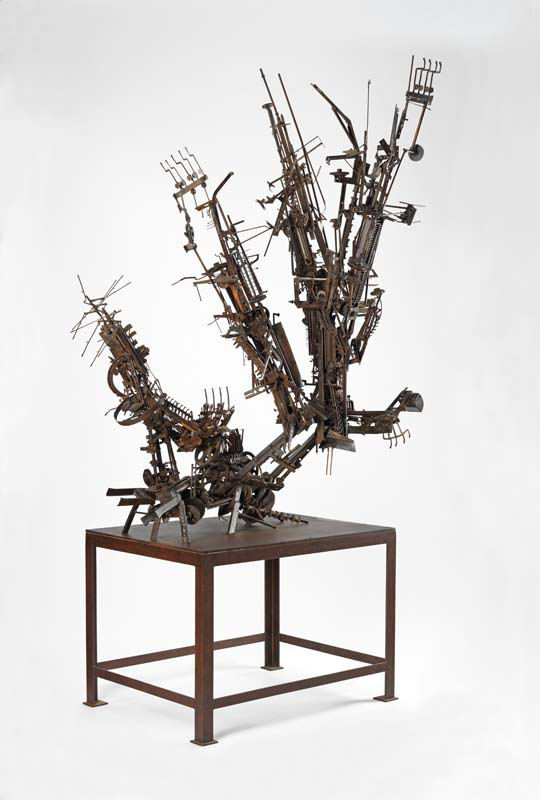We acknowledge the Traditional Owners of the land on which the Queensland Art Gallery | Gallery of Modern Art stands and recognise the creative contribution First Australians make to the art and culture of this country.

Robert Klippel / Australia 1920–2001 / No. 247 Metal construction 1965–68 / Welded and brazed steel, found objects, wood / 269 x 145 x 126cm (irreg., with base) / Purchased 1983. Queensland Art Gallery Foundation / Collection: Queensland Art Gallery | Gallery of Modern Art / © QAGOMA
Robert KlippelNo. 247 Metal construction 1965–1968
Not Currently on Display
No. 247 Metal construction 1965–68 was a major and pivotal work for Robert Klippel because it crystallised the concepts and themes that had occupied him for several years as he worked through drawings, metal constructions, and assemblage.
In this work, Klippel has transformed a disparate group of metal objects into a unified composition that is both alien and strangely familiar at the same time. Comprised of IBM typewriter parts and other recycled elements, the sculpture is essentially mechanical, although its scale and limb-like extensions suggest an organic form.
Robert Klippel is widely recognised for his abstract assemblages made from scrap metal. As a child he was fascinated with model-making and, later, produced models for the Australian Navy during service in the Second World War.
He studied sculpture, mainly wood carving, at the East Sydney Technical College, before moving to London in 1947 where he studied at the Slade School of Fine Art. In London, he regularly visited major museums, making thousands of drawings in order to develop a vocabulary of forms and shapes for his sculptural ideas.
Klippel moved to the United States in 1957 to teach at the Minneapolis School of Art. There, he became increasingly interested in discarded metal and found objects, creating welded constructions from steel-plate, copper and engine parts.
He returned to Australia in 1963 to continue his decades-long exploration of the interplay between the mechanical and the organic in the modern industrial era. Every piece of machinery he uses contributes to the organic nature of his finely resolved constructions, and every element is necessary in making the work complete.
In 1988 Klippel was appointed an Officer of the Order of Australia for his services to art.
Discussion Questions
1. The artist has reused materials from a typewriter to create this sculpture. What shapes can you see? Can you identify any of the parts or their purpose?
2. Think about the speed with which technology is changing. If Klippel was working today, what machine parts (from the last ten years) would he use?
Activities
1. In groups, design and draw a plan of a sculpture made from recycled parts, abstract or otherwise, which must be capable of standing by itself. Follow your plan to create your sculpture and give your work a title.
2. No. 247 Metal construction was made by deconstructing and reconfiguring parts from old office typewriters. Using a range of found objects, old toys/clothing, reconstruct the components by gluing, knotting, threading, stacking, wrapping or balancing them. Make a series of small sculptures as a result of this exploration. Use them as the subject matter for a series of photographs, or make a video work that records the artist’s processes.